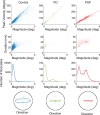Saccades during attempted fixation in parkinsonian disorders and recessive ataxia: from microsaccades to square-wave jerks
- PMID: 23516502
- PMCID: PMC3596296
- DOI: 10.1371/journal.pone.0058535
Saccades during attempted fixation in parkinsonian disorders and recessive ataxia: from microsaccades to square-wave jerks
Abstract
During attempted visual fixation, saccades of a range of sizes occur. These "fixational saccades" include microsaccades, which are not apparent in regular clinical tests, and "saccadic intrusions", predominantly horizontal saccades that interrupt accurate fixation. Square-wave jerks (SWJs), the most common type of saccadic intrusion, consist of an initial saccade away from the target followed, after a short delay, by a "return saccade" that brings the eye back onto target. SWJs are present in most human subjects, but are prominent by their increased frequency and size in certain parkinsonian disorders and in recessive, hereditary spinocerebellar ataxias. Here we asked whether fixational saccades showed distinctive features in various parkinsonian disorders and in recessive ataxia. Although some saccadic properties differed between patient groups, in all conditions larger saccades were more likely to form SWJs, and the intervals between the first and second saccade of SWJs were similar. These findings support the proposal of a common oculomotor mechanism that generates all fixational saccades, including microsaccades and SWJs. The same mechanism also explains how the return saccade in SWJs is triggered by the position error that occurs when the first saccadic component is large, both in the healthy brain and in neurological disease.
Conflict of interest statement
Figures





References
-
- Abadi RV, Gowen E (2004) Characteristics of saccadic intrusions. Vision Res 44: 2675–2690. - PubMed
-
- Martinez-Conde S, Macknik SL, Hubel DH (2004) The role of fixational eye movements in visual perception. Nat Rev Neurosci 5: 229–240. - PubMed
-
- Leigh RJ, Zee DS (2006) The neurology of eye movements. Oxford Univ Press.
-
- Martinez-Conde S, Macknik SL, Troncoso XG, Dyar TA (2006) Microsaccades counteract visual fading during fixation. Neuron 49: 297–305. - PubMed
-
- Martinez-Conde S, Macknik SL, Troncoso XG, Hubel DH (2009) Microsaccades: a neurophysiological analysis. Trends Neurosci 32: 463–475. - PubMed
Publication types
MeSH terms
Grants and funding
LinkOut - more resources
Full Text Sources
Other Literature Sources

